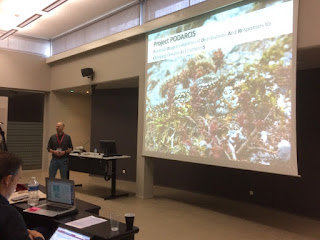Conception expérimentale (Experimental design)
To understand how lizards respond to different thermal environments and oxygen levels, we are conducting a reciprocal transplant experiment. This involves moving lizards caught at one elevation moving them to another elevation (and of course including controls of animals caught and maintained at the same elevation).
This includes lizards from the area around the SETE research station (in Moulis at about 400 m above sea level) and in the ski resort town of La Mongie (at about 1400 m). We will also move lizards to a higher elevation where they do not currently inhabit: the Pic du Midi, home of the Midi-Pyrenees Observatory (at about 2900 m). At this elevation, oxygen levels are at only about 75% of those found at sea level (which becomes quickly evident when you walk up a flight of stairs!).
This observatory is accessible only by cable car (or a long, long hike) up from La Mongie. I have to admit this is quite appealing -- I've never had an office (or, more accurately, laboratory) with a view like this!
Amazingly, another species of lizard, the Pyrenean rock lizard (Iberolacerta bonnali) lives at these high altitudes. On our first visit, we spotted one crawling among the building's walls. This species, as well as two others in this genus, are restricted to just a few high-elevation sites in the central Pyrenees. One of the aims of our study is to understand how these species might be affected by competition if Podarcis is able to migrate up mountains as the climate warms.
This includes lizards from the area around the SETE research station (in Moulis at about 400 m above sea level) and in the ski resort town of La Mongie (at about 1400 m). We will also move lizards to a higher elevation where they do not currently inhabit: the Pic du Midi, home of the Midi-Pyrenees Observatory (at about 2900 m). At this elevation, oxygen levels are at only about 75% of those found at sea level (which becomes quickly evident when you walk up a flight of stairs!).
This observatory is accessible only by cable car (or a long, long hike) up from La Mongie. I have to admit this is quite appealing -- I've never had an office (or, more accurately, laboratory) with a view like this!
Amazingly, another species of lizard, the Pyrenean rock lizard (Iberolacerta bonnali) lives at these high altitudes. On our first visit, we spotted one crawling among the building's walls. This species, as well as two others in this genus, are restricted to just a few high-elevation sites in the central Pyrenees. One of the aims of our study is to understand how these species might be affected by competition if Podarcis is able to migrate up mountains as the climate warms.
 |
| Lovely landscapes in Moulis (actually the view out the door of the apartment where I'm staying). |
 |
| Looking down at La Mongie from the cable car. |
 |
| I like to think of this as the view from my office (this is just outside the lab where we'll be conducting experiments at Pic du Midi). |
 |
| Fabien at the Pic du Midi Observatory. It looks (and feels) a bit like a space station. |


Comments
Post a Comment